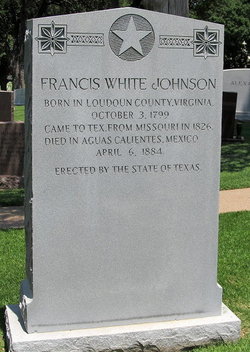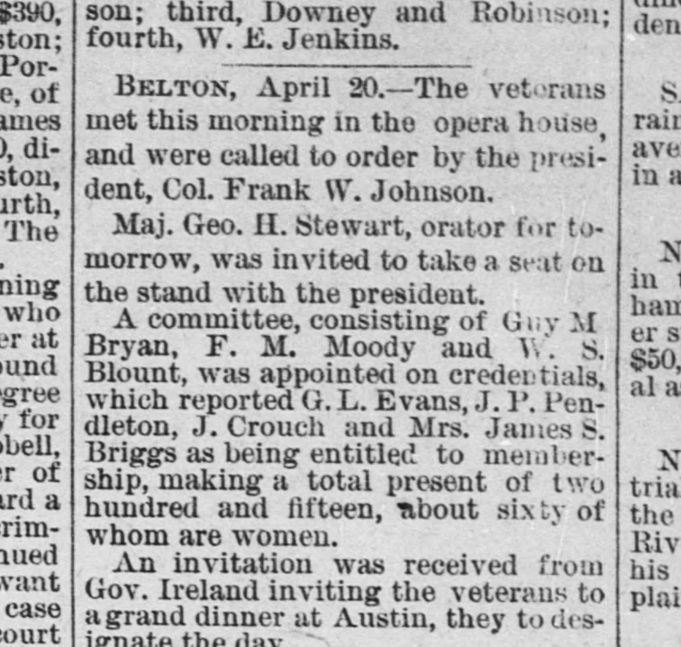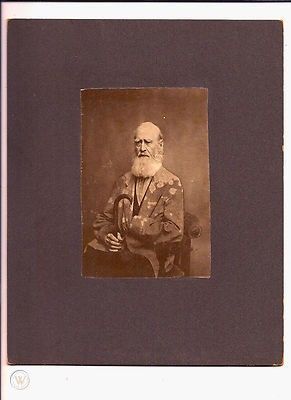Francis (Frank) White Johnson, leader in the Texas Revolution and historian, son of Henson and Jane Johnson, was born near Leesburg, Virginia, on October 3, 1799.
Headstone Text:
Francis White Johnson
Born in Loudoun County, Virginia. October 3, 1799
Came to Tex. from Missouri in 1826. Died in Aguas Calientes, Mexico April 6, 1884.
Erected by the State of Texas.
Back of headstone:
Alcaled of the Ayuntamiento of San Felipe de Austin, 1831
Commander of Texan Forces in Attack on Anahuac, June 1832.
Sec'y of the Convention of 1832. Leader, with Ben Milam, in the Storming of Bexar, Dec. 1835
In recognition of his striking service to the Texas Revolution. A joint resolution of the Legislature, Mar. 31, 1885. Provided for the interment of his remains in the State Cemetery.
*********
JOHNSON, FRANCIS WHITE
In a sketch written by himself Johnson says that he was the son and only child of Henson and Jane Johnson. He was born October 3, 1799, near Leesburg, in Loudoun county, Virginia, and one of his most vivid recollections of childhood was that of marching up and down the streets of Leesburg with the local recruits for the War of 1812. He attended the "Old Field" schools of his neighborhood, and was ready to enter an academy when his father moved to Tennessee, in 1812. Here academies and colleges were not so numerous as in Virginia, but after three more years at the "Old Field" schools he was sent to "a private or select school," where he was "instructed in geometry, mathematics, surveying, and English grammar." The last he "floundered through, understanding but little more at the end than at the beginning." "It is doubtless a good, a necessary thing," he said, "in its way, but it is not at all to my taste"; and in this he seems to have told but the simple truth, for he persisted in saying "I done it" to the day of his death. At the age of eighteen he was ready to set up for himself as a surveyor, and chose the northern part of Alabama as the field of his first operations, going there with letters of introduction to General Coffee, the surveyor general of the territory. He was promised an appointment as a government surveyor, but before receiving it changed his mind and determined to go to Illinois. At Augusta, Madison county, Illinois, he established himself, after a brief visit to St. Louis, and tested various occupations. For three months he taught school, then clerked in a store, and finally opened a "grocery store" of his own, his stock consisting of "whiskey, sugar, coffee and salt." The business did not prosper, and in 1821 he went to St. Louis county, Missouri, whither his father had just moved from Tennessee. Here he became for a time constable of the precinct in which his father lived, and captain of the Independent Rifle Company (militia). In 1824 he worked in the lead mines near Herculaneum, and quit this in 1826 to carry a cargo of produce down the Mississippi to New Orleans on a flatboat, or "broad- horn," as such boats were called.
Apparently he had no thought of going to Texas, but the voyage down the river revived a case of malaria from which he had suffered intermittently for several years, and a physician at New Orleans recommended a sea voyage to Texas. Johnson had known Col. Green De-Witt, one of the prominent colonizers of Texas, in Missouri, and had recently met him at Natchez and heard from him glowing accounts of the opportunities that Texas offered, and being by this time, as he said, somewhat indifferent about the world and its surroundings," he decided to make the trip. With the proceeds of the goods that he had brought from Missouri, he and his cousin, Wiley B. White, bought a stock of whiskey, sugar, coffee and tobacco, and set sail toward the end of July, 1826. An account of the voyage to Texas, and of Johnson's movements there down to 1834, is given in considerable detail in Chapter IX of this volume. Incidentally it presents an interesting picture of social and economic conditions of that period in Texas.
Briefly, Johnson was, during this period, surveyor of the Ayish Bayou district in East Texas in 1829, one of the leaders in the attack on Anahuac and the expulsion of Bradburn from that place in 1832, secretary of the convention which met in October of 1832 to petition the general government for the separation of Coahuila and Texas and for other reforms, and during 1833 and 1834 surveyor in the "upper colony" of Austin and Williams west of the old San Antonio Road.
Early in 1835 he became one of the more active leaders of the war party which promoted the revolution, and when the fighting began in the fall of 1835 he was among the volunteers that marched to the siege of San Antonio. He commanded a division of the force that stormed the town (December 5-9), and after the death of Milam succeeded to the full command. After the surrender of General Cos on December 9, Johnson and Dr. James Grant began preparations for an invasion of Mexico, the contemplated point of attack being Matamoras. The expedition was opposed by Governor Smith, but the General Council of the Provisional Government authorized it and appointed Johnson and James W. Fannin, Jr., to the command. Before the expedition got under way Santa Anna invaded Texas, in February of 1836, and Johnson's force was surprised at San Patricio by General Urrea and destroyed, Johnson and three or four others alone escaping. General Houston was at this time encamped on the Colorado a short distance above Columbus, and Johnson says that he joined some fifteen or twenty others and started for headquarters, "but being met on the way and informed that the army was retreating to the Brazos, we returned home. I took no further part in the struggle. I was thoroughly disgusted with the scramble for office, civil and military. I retired to the Trinity, where I remained quietly until 1839. and then visited the United States, having been in Texas thirteen years."
After his return to Texas Johnson made his home chiefly at Round Rock and at Austin. His business was that of a surveyor and land agent, but for many years he employed his spare time in collecting material for this history of Texas. He died at Aguas Calientes, Mexico, April 8, 1884. At the time he was president of the Texas Veterans' Association, and two weeks later he was re-elected by his comrades, who had not yet heard of his death. A movement was immediately begun for the return of his body to Texas, and on March 31, 1885, a joint resolution of the legislature was approved authorizing the governor to request permission from the Mexican government for its removal. The petition was granted and the remains were transferred to the state cemetery at Austin. He was a man of force and character and was honored by all who knew him. [HISTORY OF TEXAS AND TEXANS :1914]
Frank W Johnson was born in Virginia in 1794. In 1826 he located in Texas. In 1830 he was a surveyor. In 1831 he was alcalde at San Felipe. In 1832 he was commander of the force assembled at Anahuac, to resist Bradburn and to release Jack and other prisoners. In 1835 he was Adjutant to Austin and Burleson. He commanded one of the storming parties at San Antonio and on the death of Milam took command of the assaulting forces. He has for years resided at Austin. (Biographical Encyclopedia of Texas, New York, Southern Publishing Company, 1880)
Francis (Frank) White Johnson, leader in the Texas Revolution and historian, son of Henson and Jane Johnson, was born near Leesburg, Virginia, on October 3, 1799.
Headstone Text:
Francis White Johnson
Born in Loudoun County, Virginia. October 3, 1799
Came to Tex. from Missouri in 1826. Died in Aguas Calientes, Mexico April 6, 1884.
Erected by the State of Texas.
Back of headstone:
Alcaled of the Ayuntamiento of San Felipe de Austin, 1831
Commander of Texan Forces in Attack on Anahuac, June 1832.
Sec'y of the Convention of 1832. Leader, with Ben Milam, in the Storming of Bexar, Dec. 1835
In recognition of his striking service to the Texas Revolution. A joint resolution of the Legislature, Mar. 31, 1885. Provided for the interment of his remains in the State Cemetery.
*********
JOHNSON, FRANCIS WHITE
In a sketch written by himself Johnson says that he was the son and only child of Henson and Jane Johnson. He was born October 3, 1799, near Leesburg, in Loudoun county, Virginia, and one of his most vivid recollections of childhood was that of marching up and down the streets of Leesburg with the local recruits for the War of 1812. He attended the "Old Field" schools of his neighborhood, and was ready to enter an academy when his father moved to Tennessee, in 1812. Here academies and colleges were not so numerous as in Virginia, but after three more years at the "Old Field" schools he was sent to "a private or select school," where he was "instructed in geometry, mathematics, surveying, and English grammar." The last he "floundered through, understanding but little more at the end than at the beginning." "It is doubtless a good, a necessary thing," he said, "in its way, but it is not at all to my taste"; and in this he seems to have told but the simple truth, for he persisted in saying "I done it" to the day of his death. At the age of eighteen he was ready to set up for himself as a surveyor, and chose the northern part of Alabama as the field of his first operations, going there with letters of introduction to General Coffee, the surveyor general of the territory. He was promised an appointment as a government surveyor, but before receiving it changed his mind and determined to go to Illinois. At Augusta, Madison county, Illinois, he established himself, after a brief visit to St. Louis, and tested various occupations. For three months he taught school, then clerked in a store, and finally opened a "grocery store" of his own, his stock consisting of "whiskey, sugar, coffee and salt." The business did not prosper, and in 1821 he went to St. Louis county, Missouri, whither his father had just moved from Tennessee. Here he became for a time constable of the precinct in which his father lived, and captain of the Independent Rifle Company (militia). In 1824 he worked in the lead mines near Herculaneum, and quit this in 1826 to carry a cargo of produce down the Mississippi to New Orleans on a flatboat, or "broad- horn," as such boats were called.
Apparently he had no thought of going to Texas, but the voyage down the river revived a case of malaria from which he had suffered intermittently for several years, and a physician at New Orleans recommended a sea voyage to Texas. Johnson had known Col. Green De-Witt, one of the prominent colonizers of Texas, in Missouri, and had recently met him at Natchez and heard from him glowing accounts of the opportunities that Texas offered, and being by this time, as he said, somewhat indifferent about the world and its surroundings," he decided to make the trip. With the proceeds of the goods that he had brought from Missouri, he and his cousin, Wiley B. White, bought a stock of whiskey, sugar, coffee and tobacco, and set sail toward the end of July, 1826. An account of the voyage to Texas, and of Johnson's movements there down to 1834, is given in considerable detail in Chapter IX of this volume. Incidentally it presents an interesting picture of social and economic conditions of that period in Texas.
Briefly, Johnson was, during this period, surveyor of the Ayish Bayou district in East Texas in 1829, one of the leaders in the attack on Anahuac and the expulsion of Bradburn from that place in 1832, secretary of the convention which met in October of 1832 to petition the general government for the separation of Coahuila and Texas and for other reforms, and during 1833 and 1834 surveyor in the "upper colony" of Austin and Williams west of the old San Antonio Road.
Early in 1835 he became one of the more active leaders of the war party which promoted the revolution, and when the fighting began in the fall of 1835 he was among the volunteers that marched to the siege of San Antonio. He commanded a division of the force that stormed the town (December 5-9), and after the death of Milam succeeded to the full command. After the surrender of General Cos on December 9, Johnson and Dr. James Grant began preparations for an invasion of Mexico, the contemplated point of attack being Matamoras. The expedition was opposed by Governor Smith, but the General Council of the Provisional Government authorized it and appointed Johnson and James W. Fannin, Jr., to the command. Before the expedition got under way Santa Anna invaded Texas, in February of 1836, and Johnson's force was surprised at San Patricio by General Urrea and destroyed, Johnson and three or four others alone escaping. General Houston was at this time encamped on the Colorado a short distance above Columbus, and Johnson says that he joined some fifteen or twenty others and started for headquarters, "but being met on the way and informed that the army was retreating to the Brazos, we returned home. I took no further part in the struggle. I was thoroughly disgusted with the scramble for office, civil and military. I retired to the Trinity, where I remained quietly until 1839. and then visited the United States, having been in Texas thirteen years."
After his return to Texas Johnson made his home chiefly at Round Rock and at Austin. His business was that of a surveyor and land agent, but for many years he employed his spare time in collecting material for this history of Texas. He died at Aguas Calientes, Mexico, April 8, 1884. At the time he was president of the Texas Veterans' Association, and two weeks later he was re-elected by his comrades, who had not yet heard of his death. A movement was immediately begun for the return of his body to Texas, and on March 31, 1885, a joint resolution of the legislature was approved authorizing the governor to request permission from the Mexican government for its removal. The petition was granted and the remains were transferred to the state cemetery at Austin. He was a man of force and character and was honored by all who knew him. [HISTORY OF TEXAS AND TEXANS :1914]
Frank W Johnson was born in Virginia in 1794. In 1826 he located in Texas. In 1830 he was a surveyor. In 1831 he was alcalde at San Felipe. In 1832 he was commander of the force assembled at Anahuac, to resist Bradburn and to release Jack and other prisoners. In 1835 he was Adjutant to Austin and Burleson. He commanded one of the storming parties at San Antonio and on the death of Milam took command of the assaulting forces. He has for years resided at Austin. (Biographical Encyclopedia of Texas, New York, Southern Publishing Company, 1880)
Family Members
Advertisement
Explore more
Sponsored by Ancestry
Advertisement











